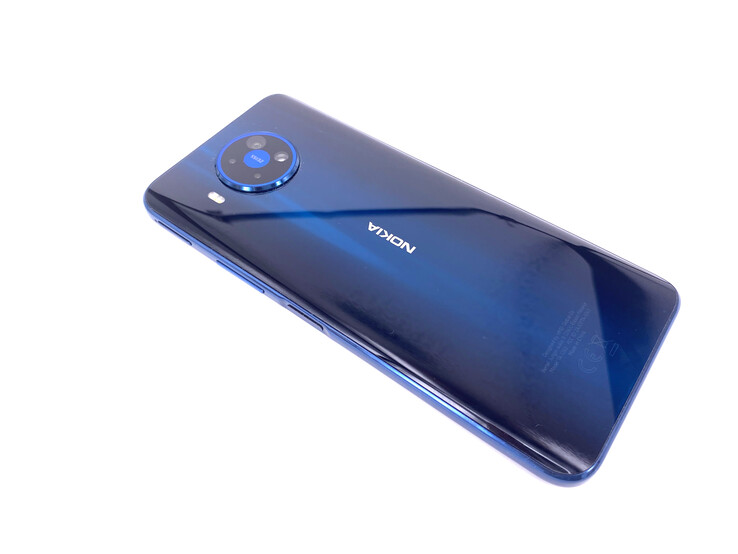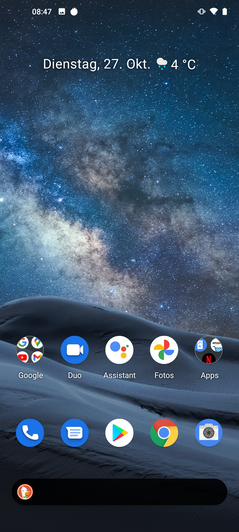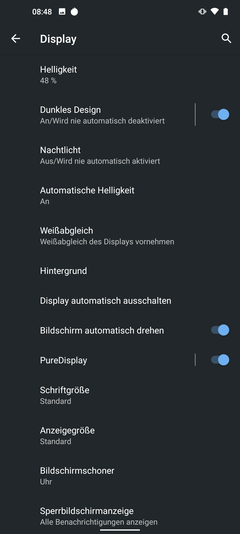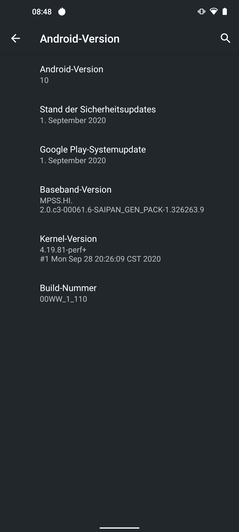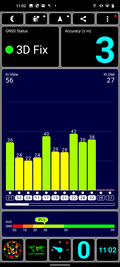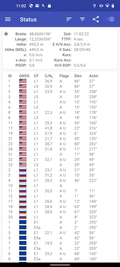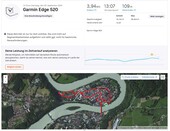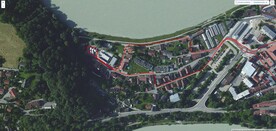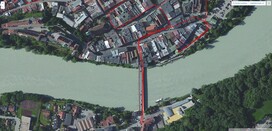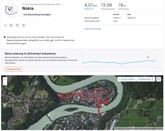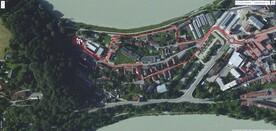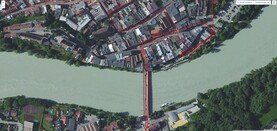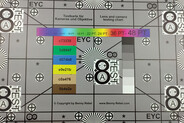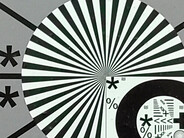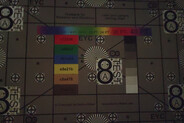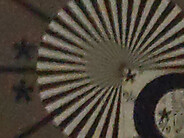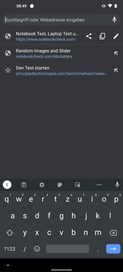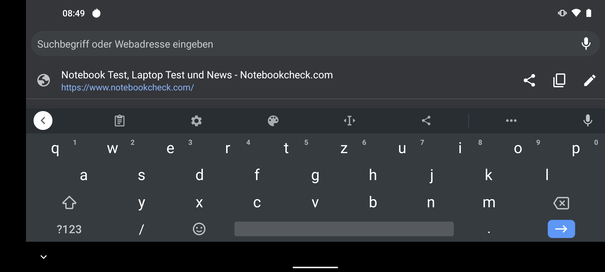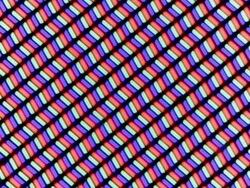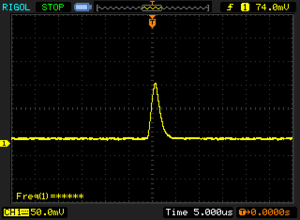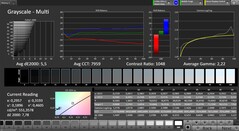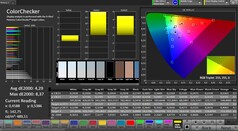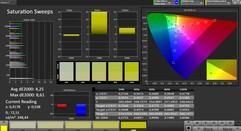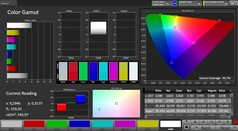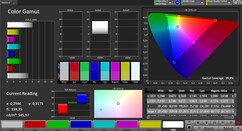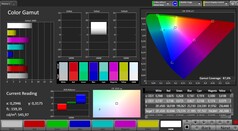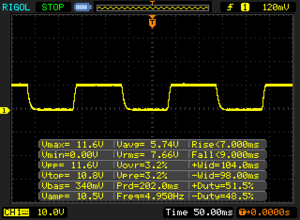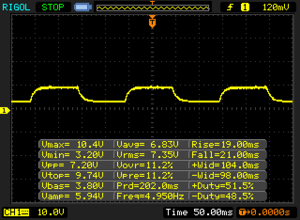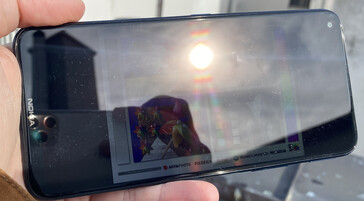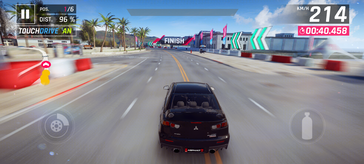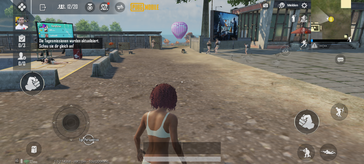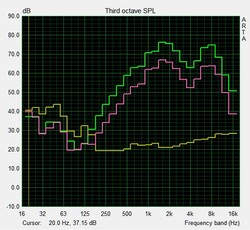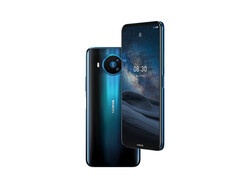Nokia 8.3 5G smartphone review – Good looks aren't enough
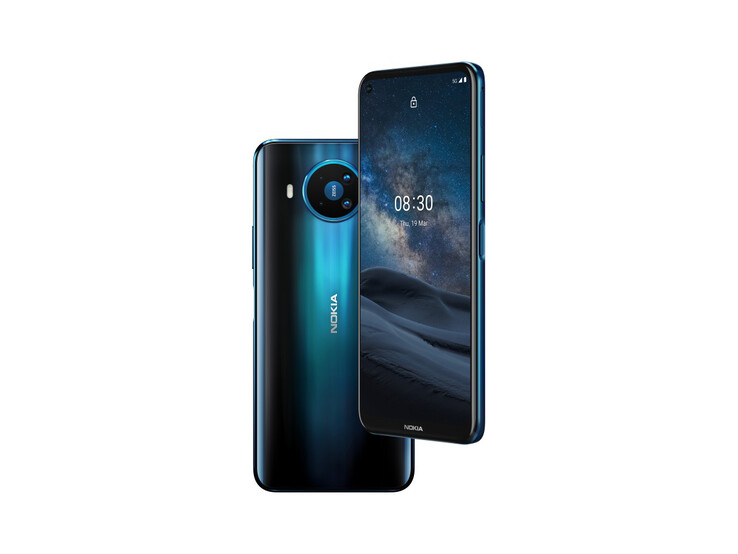
The Nokia 8.3 has come a long way: It was announced in March, but it wasn't actually launched in Central Europe until October 2020. The 5G smartphone also assists a famous secret agent in his next movie. Will the smartphone reveal secret powers in our test as well?
Comparison devices
Rating | Date | Model | Weight | Drive | Size | Resolution | Best Price |
|---|---|---|---|---|---|---|---|
| 81.1 % | 10/2020 | Nokia 8.3 5G SD 765G, Adreno 620 | 227 g | 128 GB UFS 2.1 Flash | 6.81" | 2400x1080 | |
| 87.8 % | 10/2020 | OnePlus 8T SD 865, Adreno 650 | 188 g | 128 GB UFS 3.1 Flash | 6.55" | 2400x1080 | |
| 86.5 % | 09/2019 | Apple iPhone 11 A13 Bionic, A13 Bionic GPU | 194 g | 64 GB SSD | 6.10" | 1792x828 | |
| 85 % | 07/2020 | LG Velvet SD 765G, Adreno 620 | 180 g | 128 GB UFS 2.1 Flash | 6.80" | 2460x1080 | |
| 84 % | 08/2020 | Xiaomi Mi 10 Lite 5G SD 765G, Adreno 620 | 192 g | 128 GB UFS 2.1 Flash | 6.57" | 2340x1080 |
Case – Nokia 8.3 with pretty design
The exterior of the Nokia 8.3 5G has been well designed by the manufacturer: Although only one color is offered with "Polar Night", this dark blue version is very classy. Through the back glass, you can see iridescent color effects, and the round camera module, a trademark that Motorola had abandoned in their latest devices, has apparently taken over Nokia.
Stability is convincing, but the case can be pressed in a bit in some places. The pressure doesn't transfer to the screen, though. There is no IP certification, so the smartphone should not be dropped into water.
But there is one thing that stands out negatively in terms of workmanship: The fingerprint scanner in our test sample isn't flush with the case, and the SIM drawer no longer closes flush with the case either after opening it once. This reduces the perceived quality quite clearly, which is a pity because the chassis is otherwise cleanly manufactured.
The Nokia 8.3 5G is not a small smartphone, and at 227 grams, it's also relatively heavy.
Connectivity – Some particularities
Nokia wants to charge 599 (~$704) or 649 Euros (~$763) for its smartphone, depending on the storage capacity. With the smaller model, you only get 64 GB of storage; with the larger model, you get 128 GB. RAM remains at 8 GB in both versions. This puts Nokia in the same price range in which the iPhone 11 starts, and it competes with the recently released OnePlus 8T.
The fact that it only comes with a 60 Hz display seems a bit antiquated as does the lack of Wi-Fi 6 and the USB 2.0 port. However, there is a 3.5 mm audio jack and 5G.
Storage can be expanded via a microSD card, but you have to give up one of the two SIM slots in order to do this.
Software – Android One on the Nokia 8.3
Ever since Nokia went back to Android, it has committed itself to Android One, a Google program that should ensure regular and fast updates for the devices. The Nokia 8.3 5G is also part of Android One, but the smartphone is still shipped with Android 10. Android 11 is to be delivered as soon as possible this year, the manufacturer promises. The security patches are relatively up to date.
The smartphone comes with pure Android, which is also part of the Android One promise. You don't have to struggle with too much bloatware, but two third-party apps are preinstalled.
Communication and GPS – 5G but no mmWave
The smartphone features 5G, and the manufacturer also promises the possibility of worldwide usage and correspondingly offers a number of 5G frequencies. However, the Nokia 8.3 doesn't support mmWave networks, which offer even more speed. Moreover, surfing the web on foreign 5G networks is currently only possible to a limited extent or is very expensive due to there only being a few roaming partnerships of network operators. With LTE, it should be possible to surf the web in many countries of the world, as there are numerous frequencies available. In our short test, reception is also quite strong indoors.
As far as WLAN is concerned, only the Wi-Fi 5 standard is supported, so you won't get Wi-Fi 6 speeds. Nevertheless, our test device achieves high data rates in our standardized test with the Netgear Nighthawk AX12. But the OnePlus 8T with Wi-Fi 6 shows that even more is possible here.
| Networking | |
| iperf3 transmit AX12 | |
| OnePlus 8T | |
| Xiaomi Mi 10 Lite 5G | |
| Nokia 8.3 5G | |
| LG Velvet | |
| Apple iPhone 11 | |
| iperf3 receive AX12 | |
| OnePlus 8T | |
| LG Velvet | |
| Nokia 8.3 5G | |
| Xiaomi Mi 10 Lite 5G | |
| Apple iPhone 11 | |
| Average of class Smartphone (last 2 years) | |
An exact location of 3 meters is available outdoors after a short delay. This is a very good value. The Nokia 8.3 5G can handle many different satellite networks.
Apart from minor inaccuracies, the Nokia 8.3 5G does very well in our practical test of the positioning system. Even difficult terrain like narrow alleys in the old town or roundabouts can be tracked quite reliably. Therefore, we can recommend the Nokia smartphone for navigation.
Telephone and call quality – Clearly understandable
The phone app comes from Google and should be well known to Android experts. It's structured in a clear way, and it's easy to use, even for beginners, after a short familiarization period. VoLTE and VoWiFi can be used without problems.
In our practical test, call quality proves to be decent: The internal earpiece could still use a bit of power for noisy environments, but overall, the voice of the person on the other end is transmitted quite clearly and only with a very quiet background noise. Our voice doesn't sound completely clear over the microphone but a bit distant instead; it's still quite easy to understand, though. The other person's voice sounds quite clear over the speaker and the hands-free microphone, and what we say is also well understood by them, even if we speak more quietly.
Cameras – What do PureView and Zeiss bring to the table?
There are four camera lenses on the back, but you can only use three of them for taking pictures: The fourth lens provides additional data for background blur. The main lens has a resolution of 64 megapixels; by default, it combines pixels through pixel-binning for a higher light output, and it's somewhat poorly equipped with only one phase-detection autofocus; you'll also look in vain for an optical image stabilizer. In exchange, the logo of the renowned optics manufacturer Zeiss adorns the camera. When asked, however, Nokia admitted that Zeiss didn't supply the optics for the camera here, but it only acted as a development partner and created some effects for the portrait mode together with Nokia. The camera is equipped with the company's own PureView technology, which promises improved digital zoom and a reduction in image noise.
We would like to see more sharpness from the main camera itself, since it shows clear weaknesses here. Colors also look quite dull on cloudy days; other smartphones bring out more luminosity in this regard. In low light and high contrasts, the main lens doesn't do such a bad job, and only the brightening could still be a bit stronger.
A 12-megapixel lens is used as an ultra wide-angle camera, and it delivers decent pictures. Zooming in several steps between the two lenses isn't possible; you can only switch directly between them. The third lens is a macro lens that has a very low resolution of 2 megapixels and is only used in a special macro mode.
Videos can be recorded with all three lenses, but it's not possible to switch lenses while recording. You can record videos in 4K resolution at a maximum of 30 fps with the main lens. The image quality is quite decent here, and even exposure changes aren't an issue. However, the microphone in our test device is very noisy.
Image Comparison
Choose a scene and navigate within the first image. One click changes the position on touchscreens. One click on the zoomed-in image opens the original in a new window. The first image shows the scaled photograph of the test device.
Main lens flowersMain lens surroundingsMain lens low lightUltra wide-angleEven under laboratory conditions, the photos lack sharpness upon closer inspection, especially at the edges of the images. In very low light, the subject is still recognizable, but it shows clear artifacts.
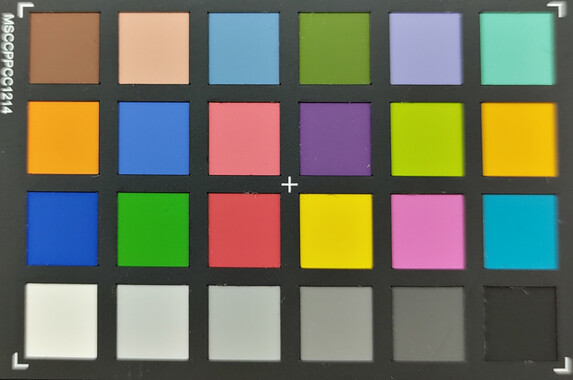
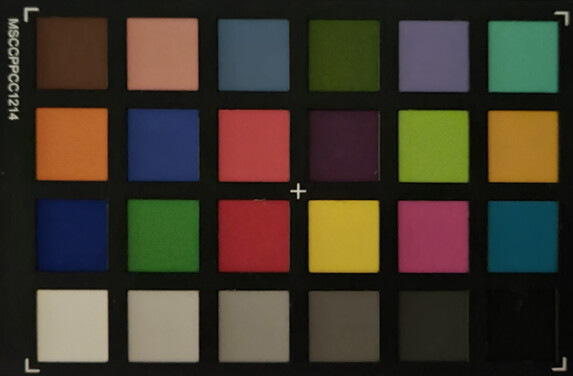
Accessories and warranty – Standard program
The package contains a charger, a USB cable, a SIM tool, and a wired headset.
There's a 24-month warranty period that also includes the battery.
Input devices and handling – Physical fingerprint scanner
The touchscreen reacts well and reliably to our inputs. In terms of hardware buttons, the volume rocker is on the right; it doesn't look so high-quality due to its plastic surface, but it has a good pressure point.
The power button is placed below, and the fingerprint scanner is integrated into it. The fingerprint is recognized reliably and only with a short delay here. However, there's a curious behavior: If you press the button in standby mode, the lock screen appears, but you have to place your finger back on again to unlock the phone. If, on the other hand, you only place your finger on the scanner, the device unlocks directly.
On the left side of the case there's another button that launches the Google Assistant.
Google's GBoard is used as on-screen keyboard. This makes it easy to work on the large screen, but if you prefer a different keyboard, you can always install another keyboard app.
Display – Uneven IPS display
The IPS display of the Nokia 8.3 5G is very large and also offers a large visible area thanks to the punch-hole camera. The width's resolution is extended 1080p, which is common in this price range. You don't need more for everyday use either; the image reproduction is fine. Higher refresh rates such as 90 Hz or 120 Hz have now become popular, but the Nokia 8.3 5G does without this and offers a maximum of 60 Hz.
In terms of brightness, our test device does quite well at first glance, but upon a closer look, it becomes apparent that there are very big brightness differences between individual screen areas. Even to the naked eye, the center of the screen looks brighter than the sides.
| |||||||||||||||||||||||||
Brightness Distribution: 82 %
Center on Battery: 669 cd/m²
Contrast: 1216:1 (Black: 0.55 cd/m²)
ΔE Color 4.3 | 0.5-29.43 Ø5
ΔE Greyscale 5.5 | 0.57-98 Ø5.3
99.9% sRGB (Calman 2D)
Gamma: 2.22
| Nokia 8.3 5G IPS, 2400x1080, 6.81 | OnePlus 8T AMOLED, 2400x1080, 6.55 | Apple iPhone 11 IPS, 1792x828, 6.10 | Xiaomi Mi 10 Lite 5G AMOLED, 2340x1080, 6.57 | LG Velvet P-OLED, 2460x1080, 6.80 | |
|---|---|---|---|---|---|
| Screen | 46% | 27% | 35% | 20% | |
| Brightness middle | 669 | 743 11% | 679 1% | 584 -13% | 586 -12% |
| Brightness | 604 | 734 22% | 671 11% | 583 -3% | 587 -3% |
| Brightness Distribution | 82 | 91 11% | 93 13% | 97 18% | 97 18% |
| Black Level * | 0.55 | 0.68 -24% | |||
| Contrast | 1216 | 999 -18% | |||
| Colorchecker dE 2000 * | 4.3 | 0.89 79% | 0.8 81% | 1.17 73% | 2.8 35% |
| Colorchecker dE 2000 max. * | 8.4 | 1.69 80% | 2.4 71% | 2.95 65% | 6.3 25% |
| Greyscale dE 2000 * | 5.5 | 1.4 75% | 1.1 80% | 1.7 69% | 2.3 58% |
| Gamma | 2.22 99% | 2.199 100% | 2.24 98% | 2.231 99% | 2.01 109% |
| CCT | 7959 82% | 6423 101% | 6610 98% | 6341 103% | 6827 95% |
* ... smaller is better
Screen Flickering / PWM (Pulse-Width Modulation)
| Screen flickering / PWM not detected | |||
In comparison: 53 % of all tested devices do not use PWM to dim the display. If PWM was detected, an average of 17924 (minimum: 5 - maximum: 3846000) Hz was measured. | |||
At 0.55 cd/m², the black level of the display is rather mediocre, so the Nokia 8.3 can't keep up with an OLED display when it comes to reproducing dark areas. Nevertheless, the display has an HDR certification.
In our tests with the CalMAN software and a spectrophotometer, we see a clear blue tint, and the display's color reproduction is rather inaccurate. There are also no preset display calibrations, and you can only optimize the white balance manually.
The response times are moderate, but at least the display shows no PWM flickering even at low brightness.
Display Response Times
| ↔ Response Time Black to White | ||
|---|---|---|
| 16 ms ... rise ↗ and fall ↘ combined | ↗ 7 ms rise | |
| ↘ 9 ms fall | ||
| The screen shows good response rates in our tests, but may be too slow for competitive gamers. In comparison, all tested devices range from 0.1 (minimum) to 240 (maximum) ms. » 32 % of all devices are better. This means that the measured response time is better than the average of all tested devices (21.5 ms). | ||
| ↔ Response Time 50% Grey to 80% Grey | ||
| 40 ms ... rise ↗ and fall ↘ combined | ↗ 19 ms rise | |
| ↘ 21 ms fall | ||
| The screen shows slow response rates in our tests and will be unsatisfactory for gamers. In comparison, all tested devices range from 0.2 (minimum) to 636 (maximum) ms. » 56 % of all devices are better. This means that the measured response time is worse than the average of all tested devices (33.7 ms). | ||
Outdoors in direct sunlight, you can hardly see anything on the display. But if you shade it, the contents are clearly recognizable. The display's visibility remains quite good when you look at it from flat angles. However, there's a slight color shift towards a reddish tone.
Performance – Okay for the high end
The Nokia 8.3 5G uses the Qualcomm Snapdragon 765G SoC, which is intended for the upper mid-range. As a result, the Nokia phone is acceptably equipped for its price class, but this SoC is also available in significantly cheaper smartphones. The OnePlus 8T, on the other hand, offers an SoC from Qualcomm's high-end segment and thus provides considerably more performance.
In everyday life, the Nokia 8.3 5G is a fast smartphone that doesn't even have to be afraid of dealing with demanding apps.
| GFXBench 3.0 | |
| on screen Manhattan Onscreen OGL (sort by value) | |
| Nokia 8.3 5G | |
| OnePlus 8T | |
| Apple iPhone 11 | |
| Xiaomi Mi 10 Lite 5G | |
| LG Velvet | |
| Average Qualcomm Snapdragon 765G (30 - 55, n=15) | |
| Average of class Smartphone (6.8 - 165, n=184, last 2 years) | |
| 1920x1080 1080p Manhattan Offscreen (sort by value) | |
| Nokia 8.3 5G | |
| OnePlus 8T | |
| Apple iPhone 11 | |
| Xiaomi Mi 10 Lite 5G | |
| LG Velvet | |
| Average Qualcomm Snapdragon 765G (31 - 56, n=15) | |
| Average of class Smartphone (9.2 - 363, n=184, last 2 years) | |
| GFXBench 3.1 | |
| on screen Manhattan ES 3.1 Onscreen (sort by value) | |
| Nokia 8.3 5G | |
| OnePlus 8T | |
| Apple iPhone 11 | |
| Xiaomi Mi 10 Lite 5G | |
| LG Velvet | |
| Average Qualcomm Snapdragon 765G (21 - 37, n=15) | |
| Average of class Smartphone (3.7 - 158, n=184, last 2 years) | |
| 1920x1080 Manhattan ES 3.1 Offscreen (sort by value) | |
| Nokia 8.3 5G | |
| OnePlus 8T | |
| Apple iPhone 11 | |
| Xiaomi Mi 10 Lite 5G | |
| LG Velvet | |
| Average Qualcomm Snapdragon 765G (22 - 38, n=15) | |
| Average of class Smartphone (6.2 - 279, n=184, last 2 years) | |
| AnTuTu v8 - Total Score (sort by value) | |
| Nokia 8.3 5G | |
| OnePlus 8T | |
| Xiaomi Mi 10 Lite 5G | |
| LG Velvet | |
| Average Qualcomm Snapdragon 765G (285731 - 332305, n=14) | |
The Nokia 8.3 5G consistently places itself in the midfield in our browser benchmarks. In everyday life, websites are loaded quickly, but you have to wait for images to load every now and then.
| Jetstream 2 - Total Score | |
| Apple iPhone 11 (Safari Mobile 13.0) | |
| Average of class Smartphone (13.8 - 351, n=172, last 2 years) | |
| OnePlus 8T (Chrome 86) | |
| Nokia 8.3 5G (Chrome 86) | |
| LG Velvet (Chrome 83) | |
| Xiaomi Mi 10 Lite 5G (Chrome83) | |
| Average Qualcomm Snapdragon 765G (15.8 - 60.5, n=12) | |
| JetStream 1.1 - Total Score | |
| Apple iPhone 11 (Safari Mobile 13.0) | |
| OnePlus 8T (Chrome 86) | |
| Average of class Smartphone (last 2 years) | |
| Nokia 8.3 5G (Chrome 86) | |
| Xiaomi Mi 10 Lite 5G | |
| Average Qualcomm Snapdragon 765G (10.8 - 96.9, n=11) | |
| Speedometer 2.0 - Result | |
| Apple iPhone 11 (Safari Mobile 13.0) | |
| Average of class Smartphone (14.9 - 445, n=157, last 2 years) | |
| OnePlus 8T (Chome 86) | |
| Xiaomi Mi 10 Lite 5G (Chrome83) | |
| LG Velvet (Chrome 83) | |
| Nokia 8.3 5G (Chome 86) | |
| Average Qualcomm Snapdragon 765G (9 - 54.9, n=9) | |
| Octane V2 - Total Score | |
| Apple iPhone 11 (Safari Mobile 13.0) | |
| Average of class Smartphone (4633 - 89112, n=210, last 2 years) | |
| OnePlus 8T (Chrome 86) | |
| Nokia 8.3 5G (Chrome 86) | |
| Xiaomi Mi 10 Lite 5G (Chrome83) | |
| LG Velvet (Chrome 83) | |
| Average Qualcomm Snapdragon 765G (3592 - 19143, n=14) | |
| Mozilla Kraken 1.1 - Total | |
| Average Qualcomm Snapdragon 765G (2359 - 15230, n=14) | |
| LG Velvet (Chrome 83) | |
| Xiaomi Mi 10 Lite 5G (Chrome83) | |
| Nokia 8.3 5G (Chrome 86) | |
| OnePlus 8T (Chrome 86) | |
| Average of class Smartphone (388 - 9999, n=172, last 2 years) | |
| Apple iPhone 11 (Safari Mobile 13.0) | |
* ... smaller is better
The fact that you can insert a microSD card into the Nokia 8.3 5G to expand storage is a nice feature. The card reader provides quite fast read speeds as we were able to determine with our reference microSD, the Toshiba Exceria Pro M501.
On the other hand, the internal storage has its speed problems and can't really keep up with any of our test devices.
| Nokia 8.3 5G | OnePlus 8T | Xiaomi Mi 10 Lite 5G | LG Velvet | Average 128 GB UFS 2.1 Flash | Average of class Smartphone | |
|---|---|---|---|---|---|---|
| AndroBench 3-5 | 81% | 44% | 20% | 7% | 178% | |
| Sequential Read 256KB | 937 | 1659 77% | 980 5% | 925 -1% | 760 ? -19% | 1505 ? 61% |
| Sequential Write 256KB | 225.6 | 728 223% | 476.9 111% | 409.2 81% | 297 ? 32% | 1112 ? 393% |
| Random Read 4KB | 117.1 | 132.6 13% | 156.4 34% | 154.3 32% | 152.9 ? 31% | 247 ? 111% |
| Random Write 4KB | 109.9 | 121.4 10% | 138.5 26% | 135.9 24% | 131.6 ? 20% | 271 ? 147% |
| Sequential Read 256KB SDCard | 87.8 ? | 77.8 ? -11% | 76 ? -13% | |||
| Sequential Write 256KB SDCard | 65.5 ? | 60.3 ? -8% | 59.6 ? -9% |
Games – 40 fps is possible
The Nokia 8.3 5G achieves a maximum of 40 fps in PUBG Mobile when playing in the "Smooth" lowest graphics setting. The game is then indeed somewhat smooth, and there are no major performance drops even at maximum details.
The situation looks a bit different with Asphalt 9: The fast racing game experiences a short but significant frame-rate drop at maximum details and stutters briefly too. We measure the frame rates with GameBench.
Our conclusion: If you want to play the most demanding games at the highest details in the future, you should choose a smartphone with a high-end SoC. But if you're a bit more frugal, you'll also get by well with the Nokia 8.3 5G in the vast majority of games.
Emissions – Nokia 8.3 with constant performance
Temperature
Nokia's Smartphone hardly heats up, which is good news. We measure a maximum of 38.2 °C (~101 °F); this should be no problem even on very hot days. We don't notice the device becoming warm at all under weak load.
Another good news: The SoC's performance isn't throttled even under prolonged load; its full capacity is always available.
(+) The maximum temperature on the upper side is 38.2 °C / 101 F, compared to the average of 35 °C / 95 F, ranging from 21.9 to 56 °C for the class Smartphone.
(+) The bottom heats up to a maximum of 37.6 °C / 100 F, compared to the average of 33.8 °C / 93 F
(+) In idle usage, the average temperature for the upper side is 26.9 °C / 80 F, compared to the device average of 32.7 °C / 91 F.
Speaker
It's questionable that Nokia only uses a mono speaker in this price range. Sound is passable, but it's very tinny at high volume. The maximum volume is good, but frequencies aren't reproduced in a very linear way.
For external devices like headphones or speakers, a 3.5 mm audio jack and Bluetooth are available. Both provide clear sound, and the pairing of devices works without issues.
Nokia 8.3 5G audio analysis
(+) | speakers can play relatively loud (83.4 dB)
Bass 100 - 315 Hz
(-) | nearly no bass - on average 67.9% lower than median
(+) | bass is linear (0% delta to prev. frequency)
Mids 400 - 2000 Hz
(-) | nearly no mids - on average 67.9% lower than median
(+) | mids are linear (0% delta to prev. frequency)
Highs 2 - 16 kHz
(-) | nearly no highs - on average 67.9% lower than median
(+) | highs are linear (0% delta to prev. frequency)
Overall 100 - 16.000 Hz
(-) | overall sound is not linear (130.8% difference to median)
Compared to same class
» 98% of all tested devices in this class were better, 2% similar, 0% worse
» The best had a delta of 12%, average was 38%, worst was 134%
Compared to all devices tested
» 99% of all tested devices were better, 1% similar, 0% worse
» The best had a delta of 4%, average was 25%, worst was 134%
LG Velvet audio analysis
(+) | speakers can play relatively loud (86 dB)
Bass 100 - 315 Hz
(-) | nearly no bass - on average 28.8% lower than median
(±) | linearity of bass is average (10.6% delta to prev. frequency)
Mids 400 - 2000 Hz
(+) | balanced mids - only 4.1% away from median
(+) | mids are linear (5.1% delta to prev. frequency)
Highs 2 - 16 kHz
(+) | balanced highs - only 4.8% away from median
(+) | highs are linear (4.5% delta to prev. frequency)
Overall 100 - 16.000 Hz
(±) | linearity of overall sound is average (21.4% difference to median)
Compared to same class
» 35% of all tested devices in this class were better, 8% similar, 57% worse
» The best had a delta of 12%, average was 38%, worst was 134%
Compared to all devices tested
» 55% of all tested devices were better, 7% similar, 38% worse
» The best had a delta of 4%, average was 25%, worst was 134%
Battery life – Fit for everyday use
Energy consumption
In terms of energy consumption, the Nokia 8.3 5G is quite power-hungry under full load, but on the other hand, you should also consider the very large screen. On the contrary, the values are at a normal level in idle usage.
| Off / Standby | |
| Idle | |
| Load |
|
| Nokia 8.3 5G 4500 mAh | OnePlus 8T 4500 mAh | Apple iPhone 11 3110 mAh | Xiaomi Mi 10 Lite 5G 4160 mAh | LG Velvet 4300 mAh | Average Qualcomm Snapdragon 765G | Average of class Smartphone | |
|---|---|---|---|---|---|---|---|
| Power Consumption | -15% | -23% | -40% | 13% | -9% | -9% | |
| Idle Minimum * | 0.8 | 1.1 -38% | 0.56 30% | 1.5 -88% | 0.66 17% | 0.965 ? -21% | 0.897 ? -12% |
| Idle Average * | 1.4 | 1.5 -7% | 2.99 -114% | 2.2 -57% | 1.58 -13% | 1.899 ? -36% | 1.452 ? -4% |
| Idle Maximum * | 1.9 | 1.7 11% | 3.02 -59% | 2.9 -53% | 1.6 16% | 2.07 ? -9% | 1.629 ? 14% |
| Load Average * | 4.4 | 4.6 -5% | 4.17 5% | 4.4 -0% | 3.3 25% | 3.98 ? 10% | 5.55 ? -26% |
| Load Maximum * | 7 | 9.4 -34% | 5.44 22% | 7.2 -3% | 5.46 22% | 6.19 ? 12% | 8.31 ? -19% |
* ... smaller is better
Battery life
The battery provides 4,500 mAh of capacity. This is a common size in this price range by now, and Nokia also manages to get quite good runtimes out from it: 15:21 hours in our WLAN test is a great score. However, the OnePlus 8T lasts a bit longer, and in many other categories, like in the idle test or under load, the iPhone 11 clearly stands out.
Nevertheless, the Nokia 8.3 5G offers a battery life that is overall very suitable for everyday use; it provides several days of usage without charging under normal use. You'll look in vain for wireless charging on the Nokia phone. Wired charging is done at a maximum of 18 watts, so it takes between 1:30 and 2 hours for the smartphone to be fully charged again when the battery level is low.
| Nokia 8.3 5G 4500 mAh | OnePlus 8T 4500 mAh | Apple iPhone 11 3110 mAh | Xiaomi Mi 10 Lite 5G 4160 mAh | LG Velvet 4300 mAh | |
|---|---|---|---|---|---|
| Battery Runtime | 2% | 28% | 36% | -20% | |
| Reader / Idle | 1489 | 1539 3% | 2765 86% | 1683 13% | |
| H.264 | 1087 | 1103 1% | 1147 6% | 1403 29% | |
| WiFi v1.3 | 921 | 1023 11% | 866 -6% | 884 -4% | 741 -20% |
| Load | 216 | 203 -6% | 267 24% | 448 107% |
Pros
Cons
Verdict – A smartphone for the niche
Yes, the Nokia 8.3 5G's launch price is too expensive considering the possible alternatives: For the same amount of money, a OnePlus 8T optionally offers more storage space and, in any case, much more power and faster charging. You can even get an iPhone 11 for the same price. Unfortunately, you can see that the smartphone took a bit too long to really be market ready; it offers what feels like last-year features.
The Nokia 8.3 5G is pretty but expensive, and it offers quite little compared to the alternatives. Nevertheless, it could find its niche.
And yet: After it becomes significantly cheaper, the Nokia 8.3 5G could offer a couple of interesting aspects to some users that are no longer found that often in devices between the high end and the upper mid-range.
The 3.5 mm audio jack is one of them. If you have issues with PWM flickering, you'll like the IPS display, and support for a microSD card is also rather rare on higher priced devices. The physical fingerprint scanner is an interesting feature as well, even when the in-screen solutions of most other devices work fine by now.
In this way, the Nokia 8.3 5G occupies a niche for fans of certain features that are rarely found in fast smartphones today. With a high-quality look and good battery life, it's a solid choice in this niche.
Nokia 8.3 5G
-
10/27/2020 v7
Florian Schmitt


 Deutsch
Deutsch English
English Español
Español Français
Français Italiano
Italiano Nederlands
Nederlands Polski
Polski Português
Português Русский
Русский Türkçe
Türkçe Svenska
Svenska Chinese
Chinese Magyar
Magyar